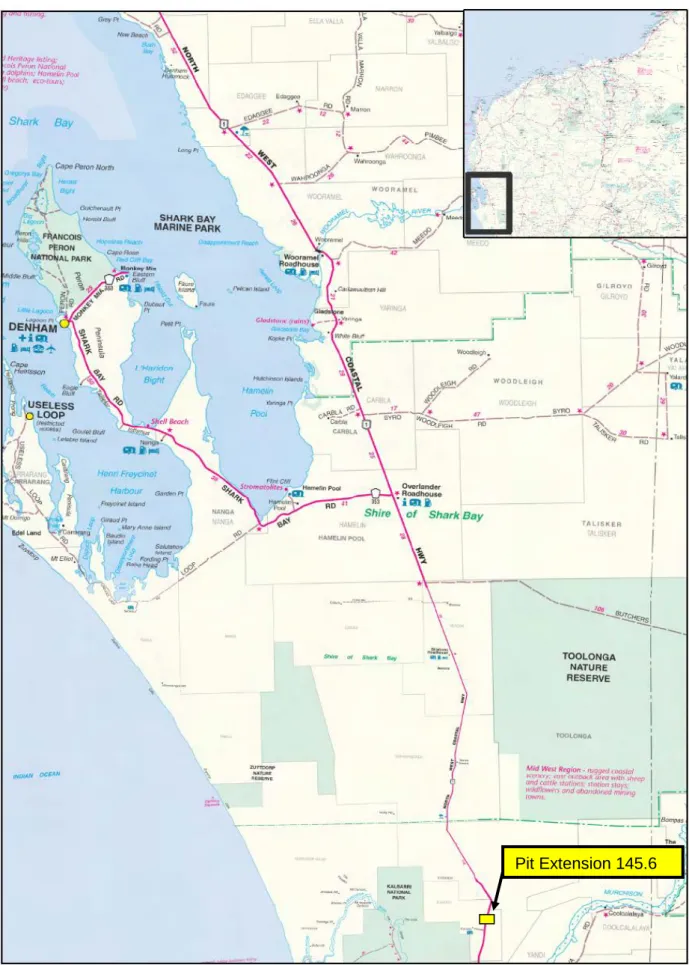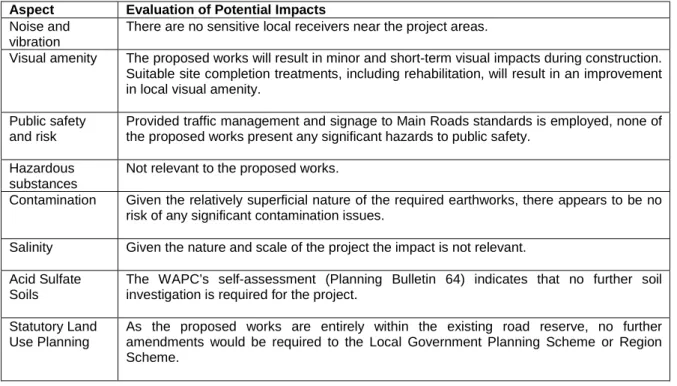Main roads Gascoyne and BGC have slowly depleted the region's gravel resources over a number of years. The expansion of numerous wells is necessary for the supply of gravel for the maintenance of the main road network and also for the supply of material in emergency situations (e.g. cyclone damage). Since the proposed works include the clearing of native vegetation, the preparation of a project-specific Preliminary Environmental Impact Assessment (PEIA) and Environmental Management Plan (EMP) is required.
Gravel Pit 145.4 SLK is located approximately 300m off the NW Coastal Highway on the right hand side. The pit access tracks are in good condition and will allow easy movement of machinery in and out of the project area.
P ROJECT L OCATION
P RELIMINARY D ESKTOP S TUDY
The decision whether or not to refer the project to the Commonwealth DEH was based on whether the project would have an impact on issues of national importance, e.g. World Heritage Sites, Protected Wetlands and Migratory Species, Commonwealth Marine Areas, Endangered Species or Communities or Nuclear Actions (See Commonwealth webpage www.deh.gov.au/epbc/assessmentsapprovals/index.html for more information and search feature page at http ://www.deh.gov.au/erin/ert/epbc/imap/map.html), see appendix G.
S ITE I NVESTIGATION
D ESCRIPTION
Given the small area of the cleanup and the mobile nature of the species found within the area, no impacts are expected. Given the type of vegetation that exists and the mobile nature of the species, the works will not affect this species. A search of the DIA database did not identify any known sites of Aboriginal heritage significance in the vicinity of the project areas in SLK 145.6.
Contamination Given the relatively shallow nature of the earthworks required, there appears to be no risk of any significant contamination issues. This part of the report (EMP) was developed for the project area after the completion of the above sections. Monitoring of weeds identified in the project area will involve the use of the input criteria listed below.
If any material of significance to Aboriginal people is discovered, work will cease immediately within 100m of the material and the site will be examined by a qualified archaeologist. Works associated with the construction of the development must not impede public access along the adjacent reserve. Ensure that the construction of the proposal is managed to a standard that minimizes any negative impact on the environment.
Ensure that the site is managed to ensure that the construction of the proposal will have minimal impact on the surrounding environment. All waste material from the development must be completely removed from the site on completion of the development. Final cleaning will be to the satisfaction of the Project Manager and the Site Superintendent.
The cover and then the top layer of soil are evenly and evenly distributed over the affected areas of the pit. The vegetation period is at least twelve months after the completion of the works. The state of the vegetation is best described as degraded due to livestock grazing and prior material extraction.
The state of the vegetation is very degraded due to the previous extraction of the material and does not present a high level of biodiversity. The state of the vegetation is somewhat degraded and does not represent an important habitat for fauna. DEC's web-based Geographic Data Atlas map tool GIS Database:. g) Native vegetation should not be cleared if the clearing of vegetation is likely to cause significant land degradation.
Native vegetation should not be cleared if the clearing of vegetation is likely to have an impact on the environmental values of any adjacent or nearby conservation areas.

S ITE I NVESTIGATION
A SSESSMENT AGAINST C LEARING P RINCIPLES
In assessing whether a project is likely to have a significant impact on the environment, the project was assessed against DEC's 10 Clearing Principles, see Appendix I.
E NVIRONMENTALLY S ENSITIVE A REA (ESA)
A search of the DEC's Fauna website indicated that the hen harrier, shield spider, Major Mitchell's cockatoo, western spiny goat, and striped hen may occur in the project areas. Consultation with DEC confirms that there are TECs in the project area and that the proposal will not have a significant impact on this environmental aspect. The only weed species observed in the project areas was Cenchrus ciliaris (Buffel Grass), which is now widespread throughout the northern regions.
This is not a problem as the project area receives less than 400 mm of average annual rainfall and is above the 26˚ parallel. Provided traffic management and signaling are used in accordance with main road standards, none of the proposed works pose a significant threat to public safety. WAPC's self-assessment (Planning Bulletin 64) indicates that no further soil investigations are required for the project.
Given the scale of the project, the low significance of its impacts on the surrounding environment and the proposed environmental management measures, the project does not require referral to the WA Environment Protection Authority or the Commonwealth Department of Environment and Heritage. The main purpose of this EMP is to provide a management plan to help minimize the environmental impacts of the activities associated with the proposed works and to identify who is responsible for their implementation.
C OMMUNICATION P LAN
VEGETATION CLEARING ASSESSMENT REPORT
Native vegetation to be cleared will be done using the Vegetation Purpose Permit. A search of the Australian Heritage Sites Inventory, Western Australian Heritage Council and Shire of Carnarvon Municipal Heritage Inventory online databases has shown that there are no listed areas of heritage significance present in the proposed areas. currently working. Given the scale and nature of the project, no emergency measures have been identified as the inherent environmental risks are low.
Given the scope and nature of the project, there is no requirement to review the implementation of the EMP as the environmental risks are small. Ensure that the overall objectives of the alignment and construction works are compatible with maintaining and, where possible, enhancing the biological integrity of the surrounding environment and minimizing vegetation loss and degradation; and. Cleaning will consist of using a brush and/or compressed air to remove clumps of soil and/or ground water slurry.
For project areas located within the pasture/pasture region north of the agricultural area as described in position statement no. 2 environmental protection authorities. The entire existing pit floor, including drainage pipes, will be excavated to a depth of 300-500mm with a spacing of 500-800mm apart (if the pit material can be ripped out). Cave 145.6 SLK is representative of Beard Vegetation Association 365, of which 93% of its pre-European extent is preserved.


